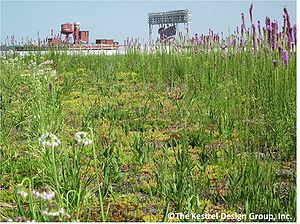
Green Infrastructure benefits of green roofs
In development
Green roofs occur at the beginning of treatment trains. Green roofs provide filtering of suspended solids and pollutants associated with those solids, although total suspended solid (TSS) concentrations from traditional roofs are generally low. Green roofs provide both volume and rate control, thus decreasing the stormwater volume being delivered to downstream best management practices (BMPs).
Contents
Green infrastructure and multiple benefits
Green infrastructure (GI) encompasses a wide array of practices, including stormwater management. Green stormwater infrastructure (GSI) encompasses a variety of practices primarily designed for managing stormwater runoff but that provide additional benefits such as habitat or aesthetic value.
There is no universal definition of GI or GSI (link here fore more information). Consequently, the terms are often interchanged, leading to confusion and misinterpretation. GSI practices are designed to function as stormwater practices first (e.g. flood control, treatment of runoff, volume control), but they can provide additional benefits. Though designed for stormwater function, GSI practices, where appropriate, should be designed to deliver multiple benefits (often termed "multiple stacked benefits". For more information on green infrastructure, ecosystem services, and sustainability, link to Multiple benefits of green infrastructure and role of green infrastructure in sustainability and ecosystem services.
| Benefit | Effectiveness | Notes |
|---|---|---|
| Water quality | Minimal wtaer quality benefits due to low pollutant concentrations. Likely to leach phosphorus during first part of lifetime. | |
| Water quantity/supply | Provides rate control (detention) and volume removal (retention) through evapotranspiration. | |
| Energy savings | ||
| Climate resiliency | ||
| Air quality | ||
| Habitat improvement | ||
| Community livability | Aesthetically pleasing but limited from public view. | |
| Health benefits | ||
| Economic savings | ||
| Macroscale benefits | Benefits are at microscale because of limited spatial extent of green roofs. | |
| Level of benefit: ◯ - none; ◔; - small; ◑ - moderate; ◕ - large; ● - very high | ||
Green Infrastructure benefits of green roofs
Because of their use of vegetation in conjunction with building design, green roofs provide multiple green infrastructure benefits.
- Water quality: Green roofs provide stormwater treatment benefits, but because pollutant concentrations are generally low, these benefits are limited. Pollutant removal mechanisms include filtering, evaporation, transpiration, biological and microbiological uptake, and soil adsorption.
Green roofs employ engineered media that is effective at removing solids, most metals, and most organic chemicals. Green roofs are generally not effective at retaining phosphorus because of the organic matter content in the media. They therefore are likely to lose phosphorus during the first years after establishment, but may gradually retain phosphorus over time.
- Water quantity and hydrology: Green roofs are effective at detaining and retaining water and provide excellent rate control, although on a small scale. The ability of a green roof to detain and retain water is a function of both the media thickness and the sorptive properties of the media.
- Climate resiliency:
- Habitat improvement:
- Community livability: Green roofs are aesthetically pleasing, though they are typically not visible to the general public. A variety of vegetation can also be used, including perennial plants, shrubs, and trees.
- Health benefits:
- Economic savings:
Design considerations
Maximizing specific green infrastructure (GI) benefits of green roofs requires design considerations prior to constructing the practice. While site limitations cannot always be overcome, the following recommendations maximize the GI benefit of green roofs.
- Water quality
- Water quantity/supply
- Climate resiliency
- Habitat
- Community livability
- Health benefits
- Economic benefits

